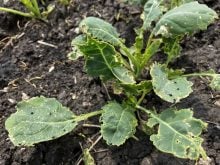It took only four days of intensive study to change the way Joe Wecker farms, to make his operation more profitable and ultimately to change his whole outlook on the world.
“Ag courses come and go, but this one was special. I had read an article about Graeme Sait and his Nutrition Farming seminar. I thought the stuff he was saying was unbelievable, so I decided to check it out myself,” Wecker said.
“I don’t know how much you can say about just another agricultural course, but this one changed everything for me. First I took the course in Ontario because he didn’t offer it in Western Canada. After, I told Graeme he had to bring this message out West, so he ran the seminar in Regina, and I signed up again. I’ll probably attend again when it runs this month in Winnipeg.”
Read Also

Growing garlic by the thousands in Manitoba
Grower holds a planting party day every fall as a crowd gathers to help put 28,000 plants, and sometimes more, into theground
Wecker farms 10,000 acres southeast of Regina with 60 percent of the farm grown organically. He signed up for the Nutrition Farming course because of a deep conviction that he should change the way he was farming.
“We can’t keep spending more money trying to chase the high yields,” Wecker said.
“This year is a good example. Durum at $6 — nobody’s even breaking even at that. We have to stop talking yield per acre. We have to start talking dollars per acre.
“If a guy is looking for a different way to farm — and I’m not talking organic here, I mean conventional farming, if you want to be more regenerative with respect to the soil — work more with nature, work more with the biology of the soil, less of a burden on the environment, less exposure to chemicals. Graeme’s course can get you started.”
Wecker said the Nutrition Farming course covers conventional biology, chemistry and fertility, but much of it deals with the significance of humus, the dark organic material in soil produced by the decomposition of vegetation and animal matter. He said the seminar emphasizes that managing humus is essential to managing soil, crops and fertility.
“As a farmer, I thought I knew about the humus aspect of nutrition, but I hadn’t realized how important it was. I think the biological activity in the soil has not been well understood until recently. You look now and see the big companies starting to deal with biologicals. Even Monsanto is bringing out biologicals now. I think that shows you where the train in going.”
He said the course changed his farm because he looks at nutrition completely differently now.
Nutrition is more than just food to grow the crop. It is also the best tool for combatting problems.
Wecker said farmers have always been taught that nitrogen, phosphorus and potassium are the most important components in agriculture.
“But I never realized before the course that every disease is linked to some nutrient. On our farm, I haven’t sprayed a fungicide in four years. At first I didn’t believe we could do it, but we’ve figured out that if there’s a disease or insect pressure, it’s always because of a lack or an oversupply of a certain nutrient. We can turn plant disease on and off by controlling nutrition.
“Sclerotina, for example. We start with a tissue test to tell us what nutrients are deficient in the plant. When we get the results, we go and apply whatever is deficient as a foliar application. We apply boron on just about every variety of every crop, especially canola and mustard. An application of boron is about $2 per acre plus application. Of course you have to chelate it yourself.
“Fusarium is the exception. We’ve not found a nutritional link to fusarium. The fusarium starting point is the biology in the soil or the lack of biology. So what we do is apply a biological fungus that colonizes the plant so there’s no room for fusarium to attach to the plant. It gets us away from a chemical application. There’s no carry-over and no side-effect. It costs us $2 per acre plus the cost of application.”
In the course, Sait tells farmers that when they apply NPK they should chelate it or apply it with humic acid. By following this recommendation, Wecker said he has cut back on his nitrogen by 50 percent over a three year period without a sacrifice in yield. He said he is now at about 50 percent of what other people call normal rates.
“Timing has a lot to do with it. We broadcast 28-0-0 UAS at the six-leaf stage because that’s when the plant needs it. On our phosphate, we use Alpine on the conventional fields. Last year we used a lot of guano from Australia on the conventional side of the farm. It’s shipped as a liquid.
“On the conventional side, we’ve been cutting inputs for the past four years and our yields have stayed the same. We actually out-yielded our neighbour with less than half the fertilizer. On the organic side, it’s been profitable, just about double what the conventional side is.
“We only cultivate if it’s absolutely necessary, on the conventional and on the organic. I hate cultivating. I don’t see it as a hobby or something to pass the time. If we do cultivate a field, it’s only one a year.”
While the tillage equipment may sit idle, most of the nutrients are foliar, so the sprayer does see a lot of action. The air drill is equipped for liquid, so humic acids and biological agents can be applied at seeding time. Wecker does not spray desiccants, so the swather also sees a lot of work at harvest. Wecker intercrops as many as three crops simultaneously, so he straight cuts those fields.
“Nutrition farming is not more time consuming. I’m just spending my time on crop health and nutrients rather than fungicides or insecticides. The organic part is more time consuming because timing is so important. I need an extra full-time person on the organic side to get everything done on time.”
Graeme Sait’s Nutrition Farming seminar will be presented in Winnipeg Nov. 26-29.


















